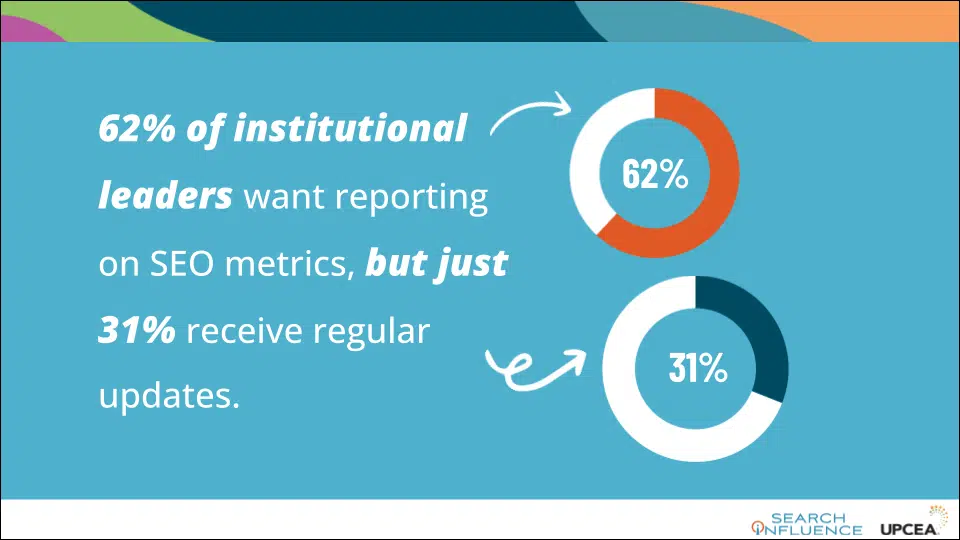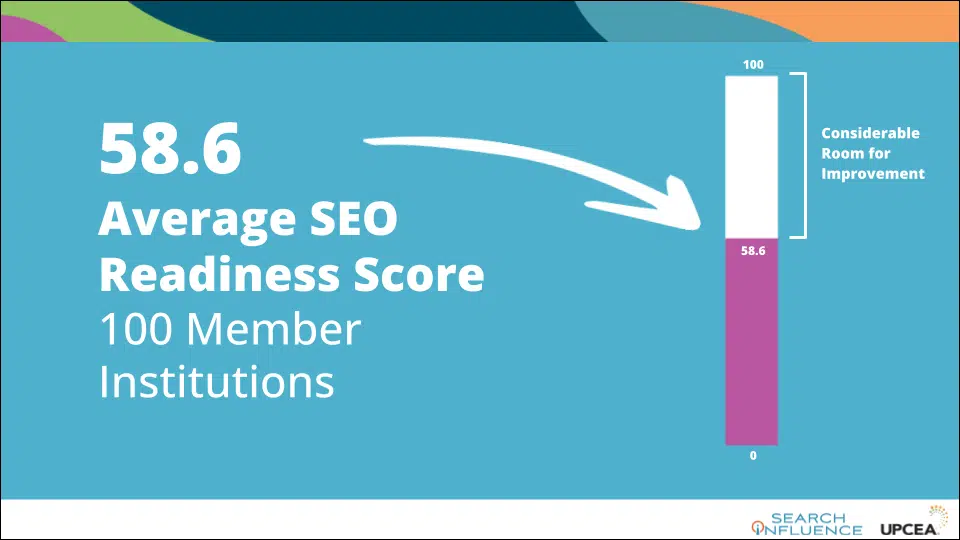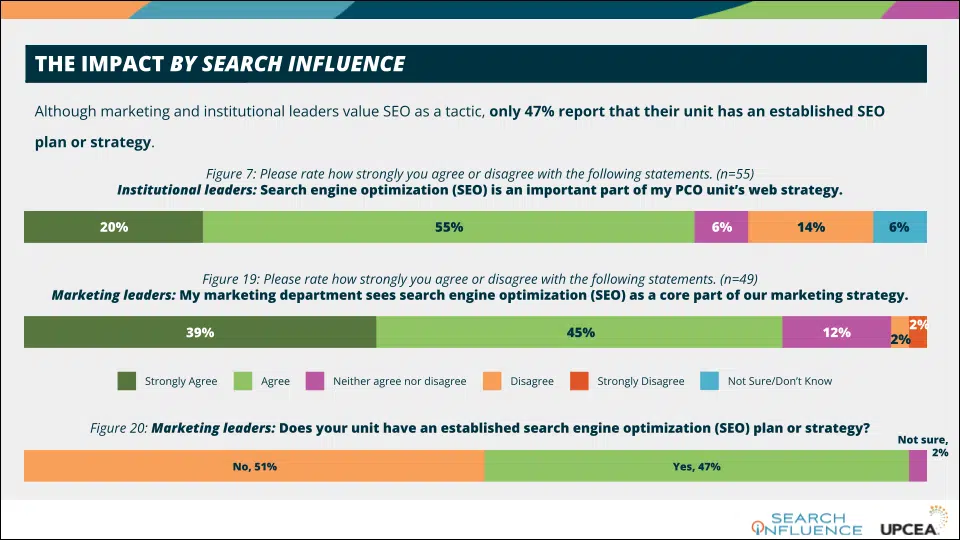How higher education is failing at SEO
Marketers and institutional leaders see SEO as foundational but admit their units lack an SEO strategy, a recent study found.
As academic institutions continue to focus on providing quality education and research, their online visibility is often neglected.
This means that potential students may be unable to find them easily on search engines, leading to missed opportunities for growth and impact.
In the fall of 2022, Search Influence commissioned a study with the research team at UPCEA, the preeminent trade organization for professional, continuing and online (PCO) education. Here’s what we found.
Attracting new learners through organic search
With the millions of dollars spent in higher education digital marketing and advertising, there is very little understanding of search engine optimization and its role in attracting new learners.
With this belief, we commissioned a multi-part study which:
- Reviewed 100 websites of university professional and continuing education departments.
- Surveyed marketing leaders and institutional leaders.
In this mini-audit, the UPCEA team reviewed several factors we call SEO readiness. These include common SEO and user experience metrics, such as:
- Number of unique pages (titles).
- Unique meta descriptions.
- Number of inbound links.
- Domain and page authority.
- Accessibility.
The UPCEA team surveyed both marketing teams and institutional leadership to understand their perceptions of – and alignment around – their own readiness.
At the risk of telegraphing the punchline, there are some big disparities.
In his introduction to the published research study, Jim Fong, Chief Research Officer at UPCEA, emphasizes the need for innovative practices, models, and credentials tailored to nontraditional and professional audiences, such as stackable degrees, non-credit programs, and micro-credentialing, among others.
Fong points out that reaching new adult learners requires precision, planning, and better prospect and student interfaces. These learners are savvier than previous generations, relying on various sources of information and influencing others through their outcomes.
One critical area of improvement lies in optimizing the degree programs’ “storefront” – the institution’s website – for better user experiences.
While Fong is cautious not to create panic, he believes a greater sense of urgency is needed to address the impending challenges in higher education.
With the labor shortage and a decline in the population of college-age students, universities need to do more to stay relevant to all learners, not just recent high school graduates.
It’s not unusual for individual PCO units in major universities to spend a million dollars or more on digital advertising.
And as we see in the research, those same departments are not even sure their teams are doing SEO.
The state of SEO in higher education
The UPCEA/Search Influence research highlights the perceptions and comprehension of SEO among institutional and marketing leaders. It also points to the potential impact on the SEO preparedness of the institutions involved.
Some key findings from the study:
- Marketers and institutional leaders see SEO as foundational but admit their units lack an SEO strategy.
- Institutional leadership often lacks reporting.
- UPCEA members performed poorly in an SEO audit.
84% of marketing departments see SEO as a core part of their marketing strategy, but half (51%) do not have an established SEO strategy
The disconnect is pretty striking. When so many see it as valuable, but so few have a strategy, we have to ask ourselves, “Why?”
Some possible reasons are:
- SEO seems too complex.
- Digital advertising (and its return) is easier to understand.
- The ROI of SEO isn’t clear to decision-makers.

I’m often asked when talking to leaders, both academic deans and directors of marketing, if we have case studies on the ROI of SEO.
We do, of course, but it’s still surprising that these senior professionals don’t make the connection.
If they’re willing to pay to be at the top of Google rankings, earning their way, there is imminently more valuable.
The difference between Page 5 (essentially nonexistent) and Page 1 can mean hundreds of additional visits and thousands of dollars in revenue.
Institutional leadership often lacks reporting
Despite the indication that institutional leaders want reporting, a few of them are getting it.

It’s possible that marketing teams don’t know how to quantify their SEO efforts, or perhaps worse, they don’t know what efforts are being made.
‘SEO readiness’ has room for improvement
Among the more surprising revelations was the number of sites that were not 100% accessibility compliant.
Our testing tool for accessibility, accessiBe’s accessScan, evaluates whether a website is non-compliant, semi-compliant, or compliant.
A vast majority of institutions (81%) were just semi-compliant. Our clients report this is a hot-button issue for their administrations.
Furthermore, there are several lawyers who perceive it as an area of opportunity for trolling as well.

SEO is essential to drive organic traffic from potential students.
A weak SEO foundation can negatively impact ranking factors and significantly hinder a website’s ability to attract potential students.
We often hear from higher education institutions that they are “doing SEO.” But we wonder – is it being done strategically?
From our experience, a comprehensive digital marketing strategy is critical for schools that want to meet their enrollment goals.
The results of this research demonstrate that SEO is an area of opportunity for many universities.
Overcoming challenges and embracing innovation
Although marketing and institutional leaders value SEO as a tactic, only 47% report that their unit has an established SEO plan or strategy.

This disconnect suggests that, while marketers know SEO’s critical role, they may not have the skills, staff, or resources to develop a strategy.
Most web traffic comes through organic search, i.e., utilizing popular search engines such as Google.
This means regardless of where prospects are in their student journey, they expect a search engine to answer their questions about the availability of programs, applying, and even enrollment.
Common challenges for educational institutions implementing SEO strategies
Centralized control of marketing and ‘webcomms’
In many higher education institutions, centralized departments are responsible for many functions.
Like facilities and food service, IT, communications, and marketing often reside at or are directed from the university level rather than in the individual departments.
In some cases, there are individuals or teams charged with marketing at the department level. Often, they are constrained by the brand guides, templates, and technology choices made at the institutional level.
In a minimal number of cases, we have seen individual departments or units allowed to make their own technology choices as long as they stay within the general guidelines of the parent organization.
Institutional support for IT, marketing and SEO
These centralized teams are beholden not to the individual department but to the university or college.
While they intend to serve all departments equally, what we have seen is typically one of two conditions: favored programs get more institutional resources, or all programs get basic support.
With this as the reality, the most likely scenario is that there are not enough human and financial resources in an area (like SEO) that isn’t as tangible as email marketing or advertising.
When an individual department is in control of their marketing and their website, we see it as a great advantage. While they have less institutional support, they also have less institutional oversight and control.
Maintaining and growing knowledge of SEO
In cases where there are department-specific web support or marketing teams, they are charged with many functions. They are updating faculty bios, course descriptions, social media and more.
They are often generalists without deep knowledge of the technologies they manage.
It is challenging enough to establish a foundational understanding of SEO, digital ads, email marketing, social media, and website technologies – even more to maintain up-to-date best practices in an ever-changing field.
Most marketing leaders recognize that there is room for improvement in the SEO capabilities of their unit, scoring their knowledge with an average rating of 3.5 out of 5.
Higher education CMS issues
In addition to the institutional challenges to good management of the websites, there are CMS challenges as well.
In our study, the most-used CMS platforms for university websites are:
- Drupal (31%).
- Cascade (17%).
- WordPress (15%)
- Omni (6%).
Other platforms mentioned included Blackboard, Slate, Adobe Experience Manager, and Terminal 4, among others.

With so many CMS platforms within these PCO units, content management likely requires more training and support than in more commonly used systems, such as WordPress.
The challenge is pretty clear. Inconsistent support, teams with many roles, centralized command and control, and hard-to-manage systems mean not much will get done, even with the best intentions.
Is there a silver bullet for higher education SEO?
Sadly, there’s none.
In the best case, administrative leadership would come to understand the importance of SEO for higher education.
Unfortunately, it doesn’t seem those administrators are making the connection between their important work – growth, fund-raising, enrollment, research – and SEO.
For most departments in higher education, SEO is an afterthought.
Best practices for higher education SEO
SEO basics
Without doing a deep dive into the basics of SEO, there are a few things that we know to be true.
Relevance + Authority = Winning in search engines
The shortest version of what good SEO looks like is:
In other words, are you saying the things people are searching for on your pages?
Do search engines understand that yours is a trustworthy and respected website deserving of their traffic?
Higher ed SEO has an unfair competitive advantage
Given the importance of relevance and trust (surely you’ve heard of E-E-A-T), there are few more trusted websites than those associated with educational institutions.
In Maslow’s Hierarchy of link building, .edu links are right up there with self-actualization. They are the definition of what makes a good backlink.
They have authority, relevance, trust, and lots and lots of actual user traffic. In academic research, this would be considered an authoritative citation.
Think about it, they publish constantly and much of their content is research people are interested in.
They get tons of branded searches from prospective students. And they’re responsible for significant contributions to their local economy.
So as an academic unit within a university, your ability to appear for relevant searches is amplified. All you need is great content.
In higher education, content optimization is critical
The great news is that individual units are responsible for one of the most critical factors in university SEO: content.
If I control the content, I can control how it’s optimized. I can often control the formatting, including the use of headings and other on-page optimization elements. I can also likely control what is being linked to from within the content.
So, from our perspective, focusing on content is one of the most important – and realistic – things that any unit within a higher education institution can do for SEO success.
This is not to say they don’t need to be thinking about technical SEO. If there are critical failings within their technical infrastructure, they will have a harder time reaching prospective students.
But, if they can build relevant content and get good links, they’ll be a lot more likely to rank well in search than another site might, given the inherent authority of their university website.
Understanding what good content looks like becomes critical for those marketers working within those university units trying to attract new learners.
Getting started with higher education SEO content
Temet Nosce. As the Greek maxim states, it is important to know oneself.
One of the most important tools a higher education marketer can have is Google Search Console. Obviously, one has to take anything Google says with a grain of salt, but there are some good reasons to start with Search Console.
- It’s free.
- The information is pretty easy to understand compared to other tools.
- It shows you Google’s point of view.
A good starting point for higher ed marketers is to look at what queries their pages already show up for.

With Google Search Console, you can see what phrases Google already thinks your website contact is relevant for.
Starting with those queries you’re already doing well for. You can start to think competitively.
A review of competitive sites can give you some good clues about what you must do to get over the top.
- Do they have more content?
- What are the features of that content?
- More images, more headers, more text, video?
- Do they have more links?
- You may need tools for this one.
- A good free option is the SEOquake extension. You’ll need a free Semrush account that gives you access to many SEO metrics.

With the data from the above investigation, you’re now able to start outlining content.
The best web content is like a persuasive essay. Present the important information and then bring it home with a strong call to action.
In any industry, and especially in higher ed, it’s less about the words and more about the journey.
Just because people are searching for a phrase doesn’t mean that those people are prospective students.
Educating stakeholders on the value of SEO
It’s easy for us to look at a problem and see a marketing solution.
SEO is a foreign language to many, and as this study proves it is still not understood as a great way to drive ROI for higher education.
In the review of your own site, analysis of competing sites, and optimization of your content, you are never done. The key is to develop a system and cadence that work for you.
Whether due to complexity, lack of knowledge, or institutional inertia, SEO is not getting its due in higher ed. There are a lot of considerations outside the control of the folks executing the strategies within higher education marketing.
Our job is to support them. We must provide the best knowledge we can, meet them where they are, and ensure we are not asking them to do things that, in their situations, are “impossible.”
The UPCEA study shows much room for improvement in higher ed SEO. There are some winners in the analysis who still have opportunities for improvement.
By focusing on function and form, higher education marketers can start where they are within their current constraints:
- Create great content.
- Build links, even if they’re just internal.
- Get better placement in organic search so they will be less dependent on paid advertising.
Opinions expressed in this article are those of the guest author and not necessarily Search Engine Land. Staff authors are listed here.
Related stories
New on Search Engine Land